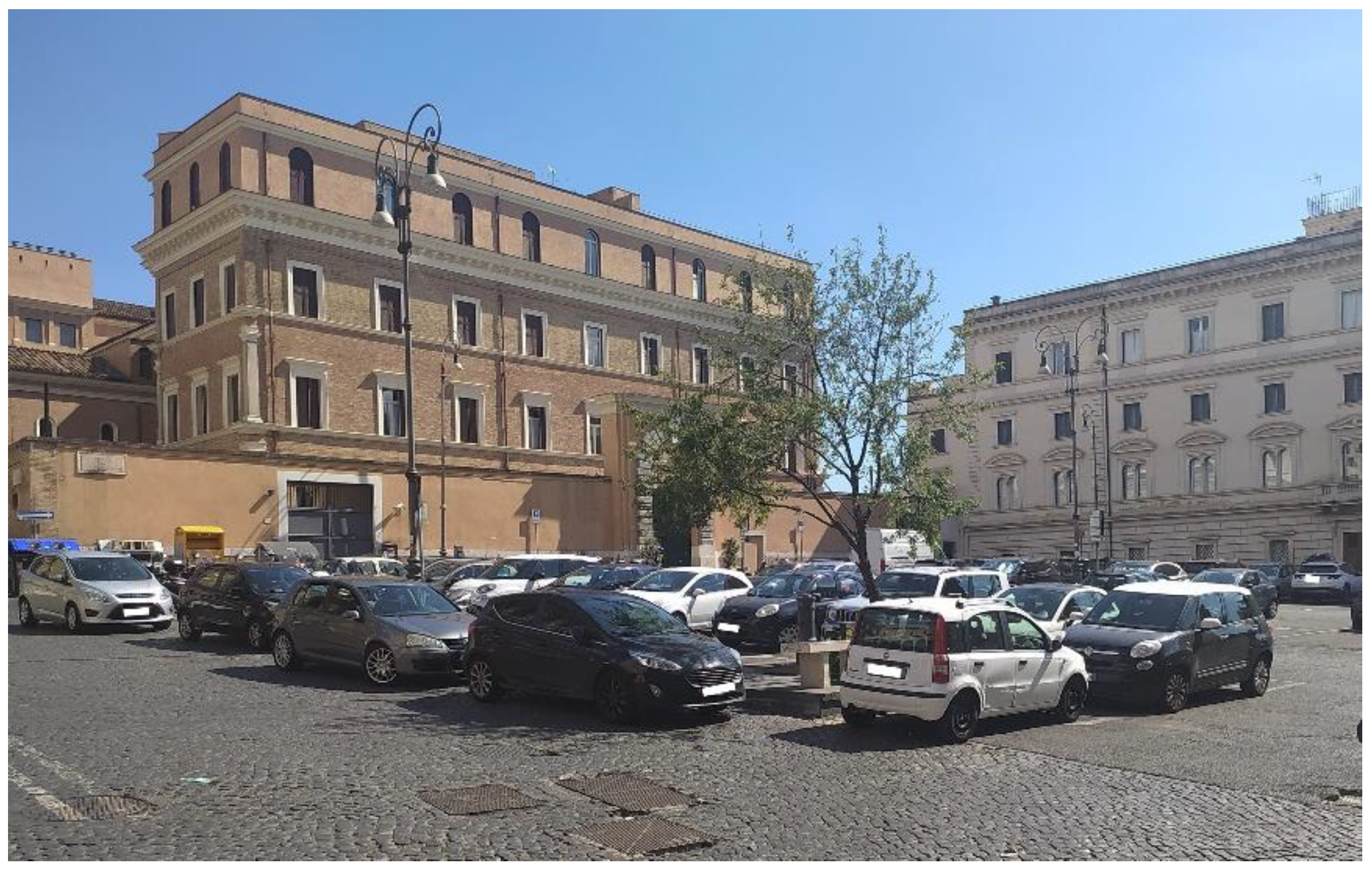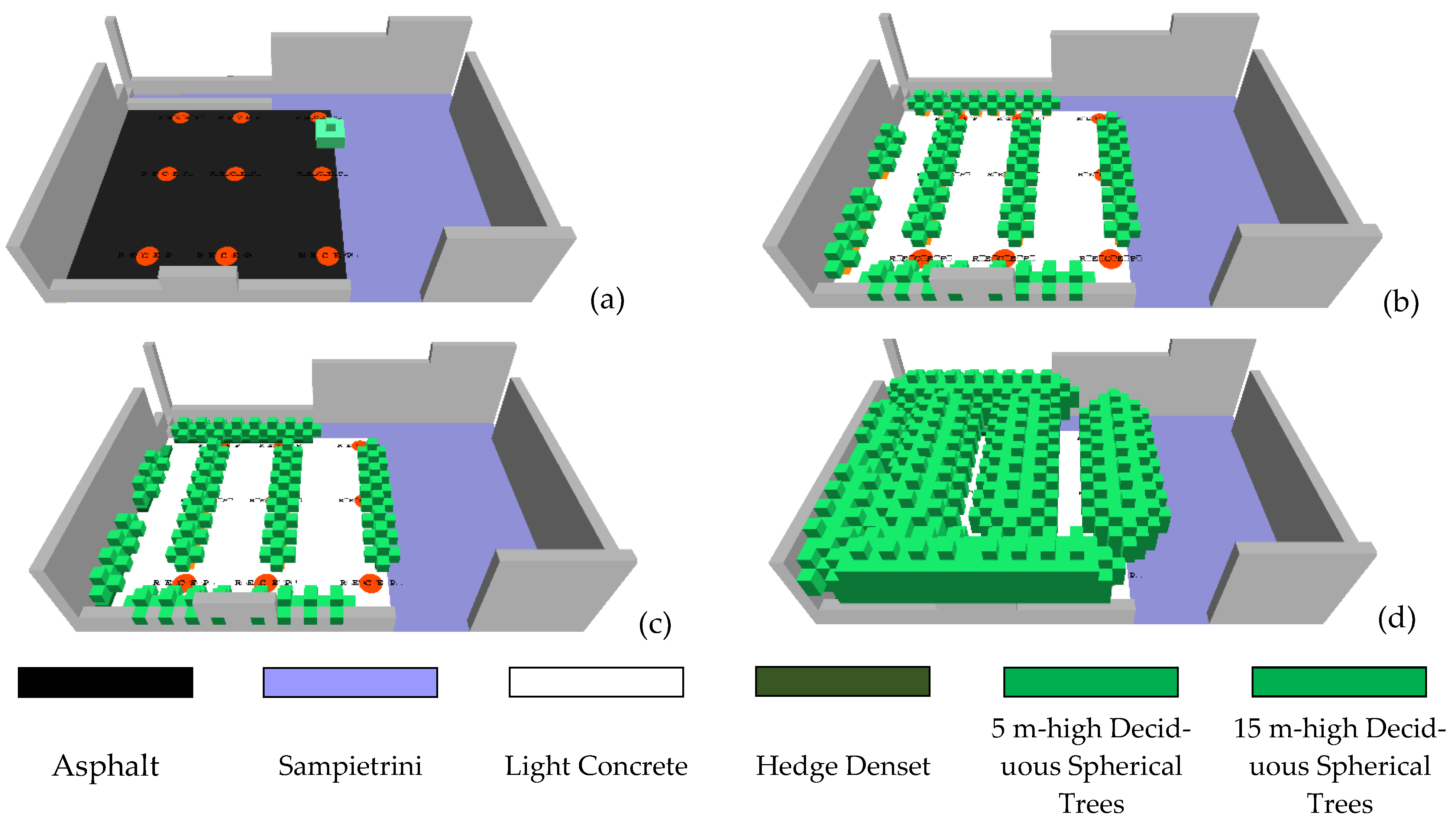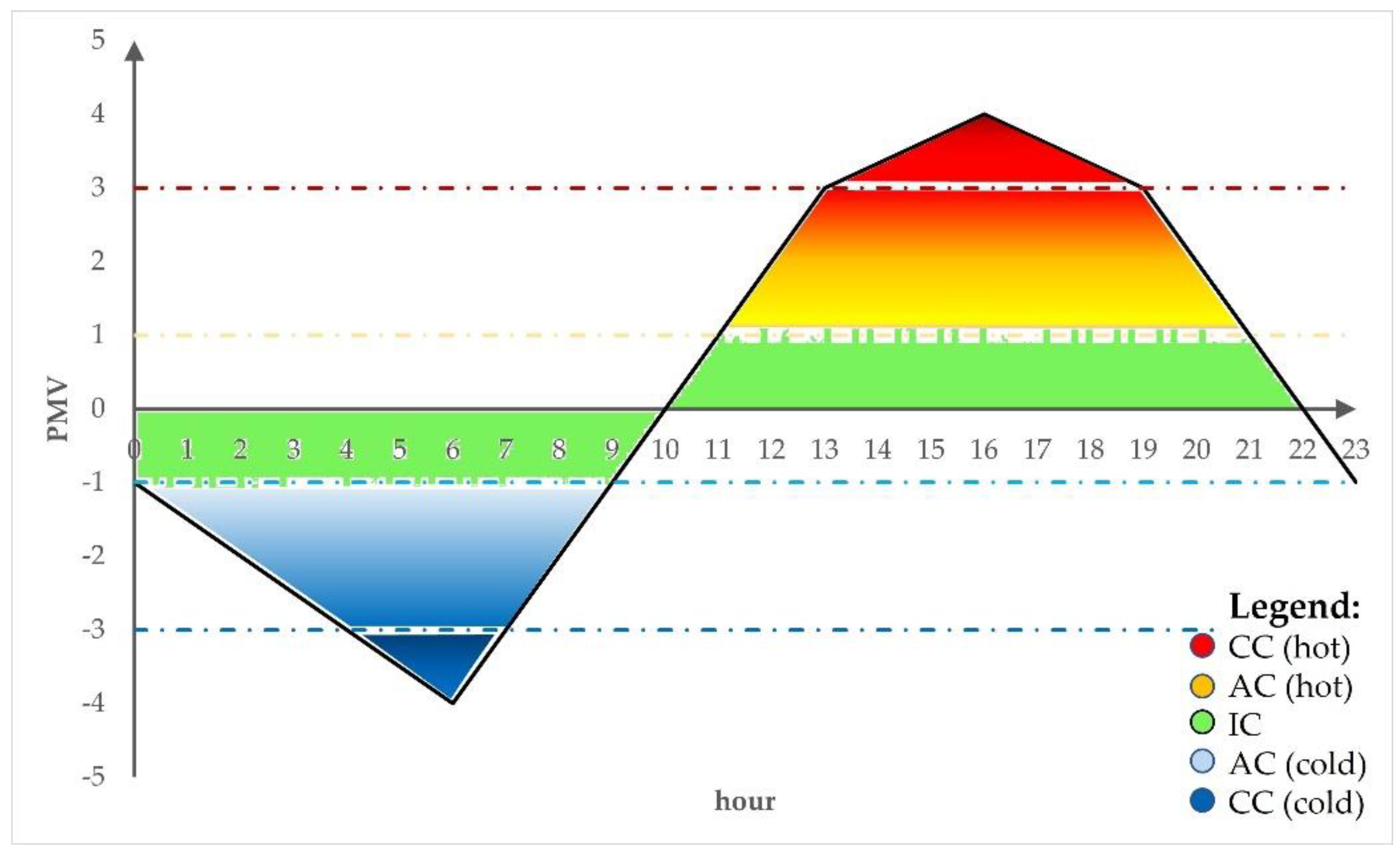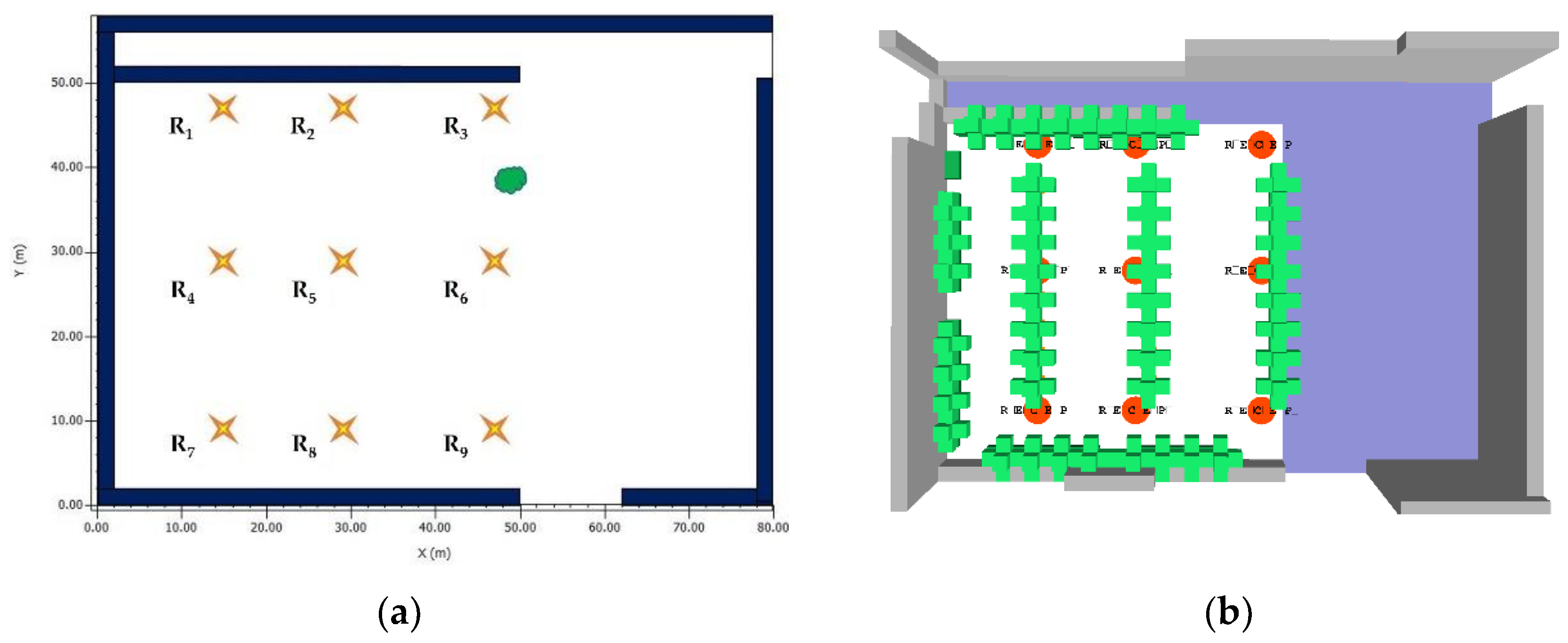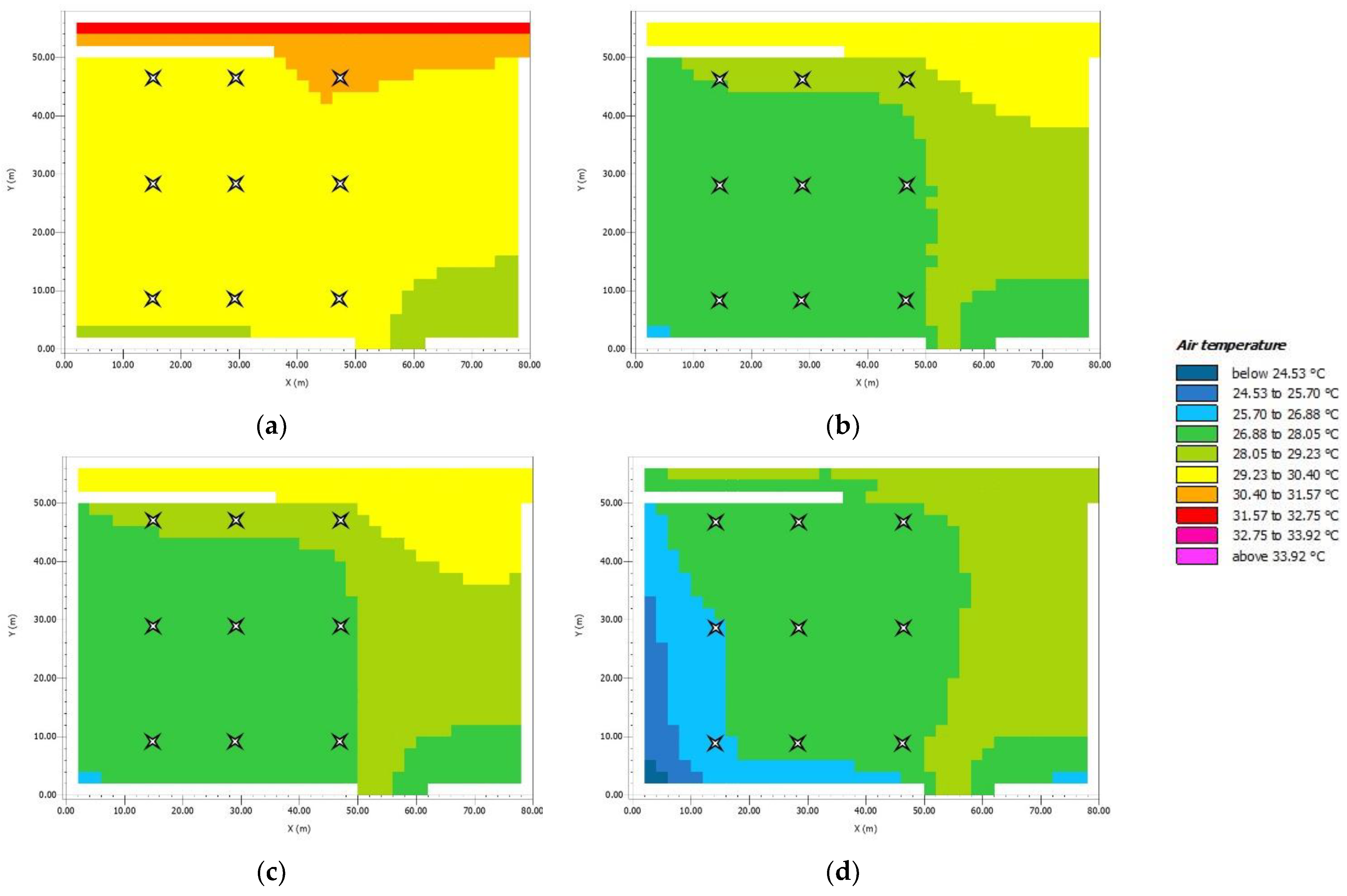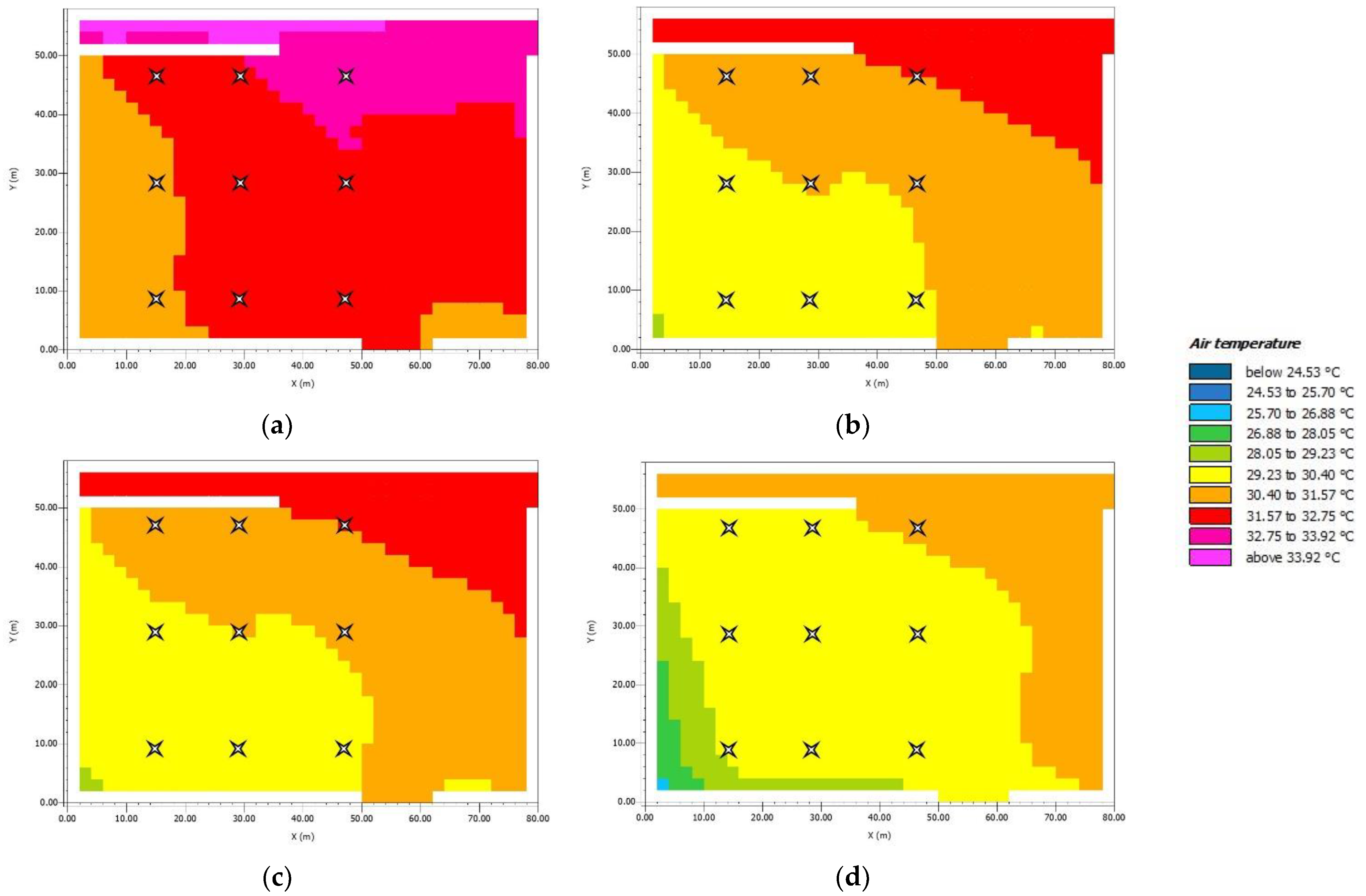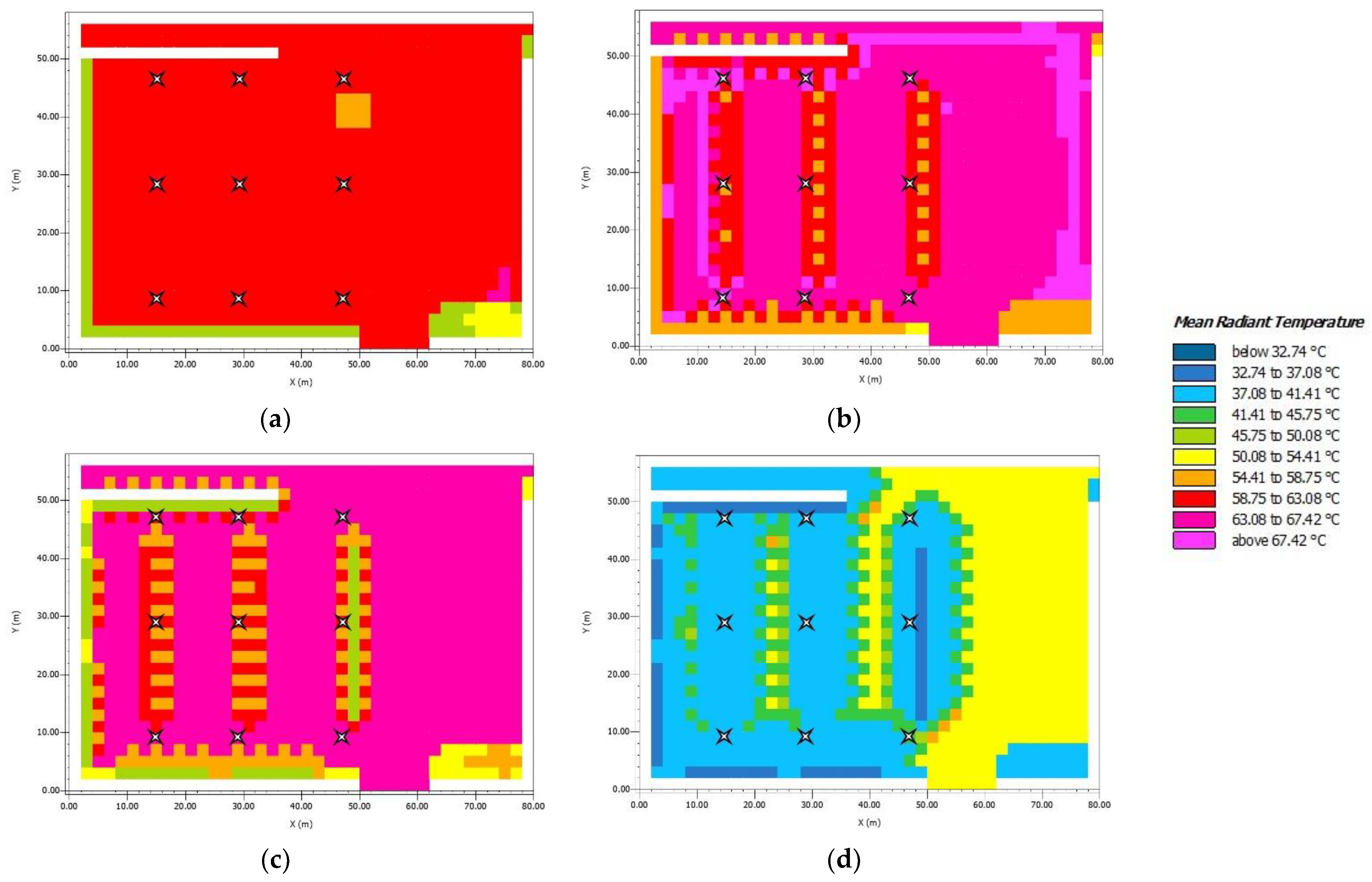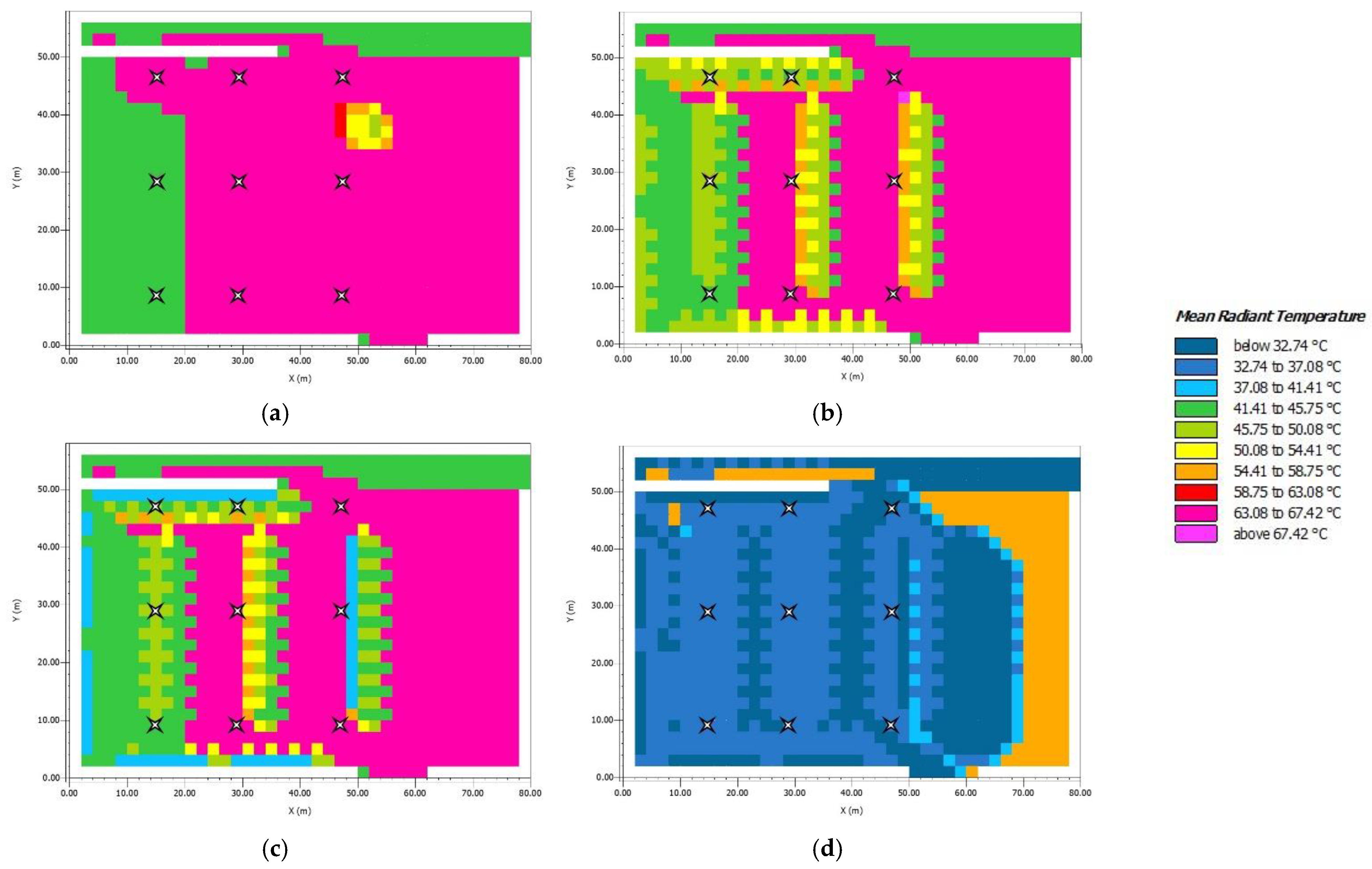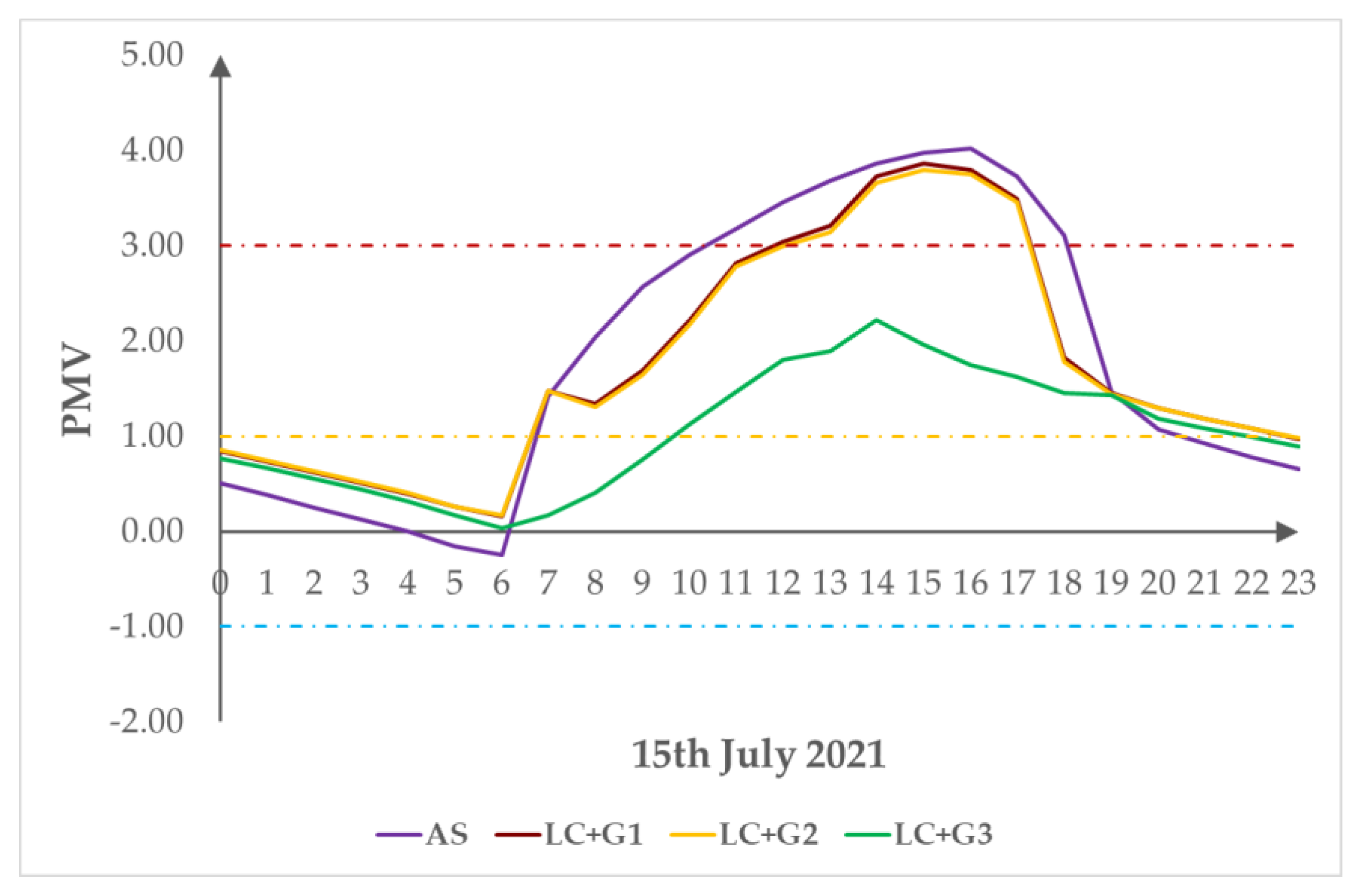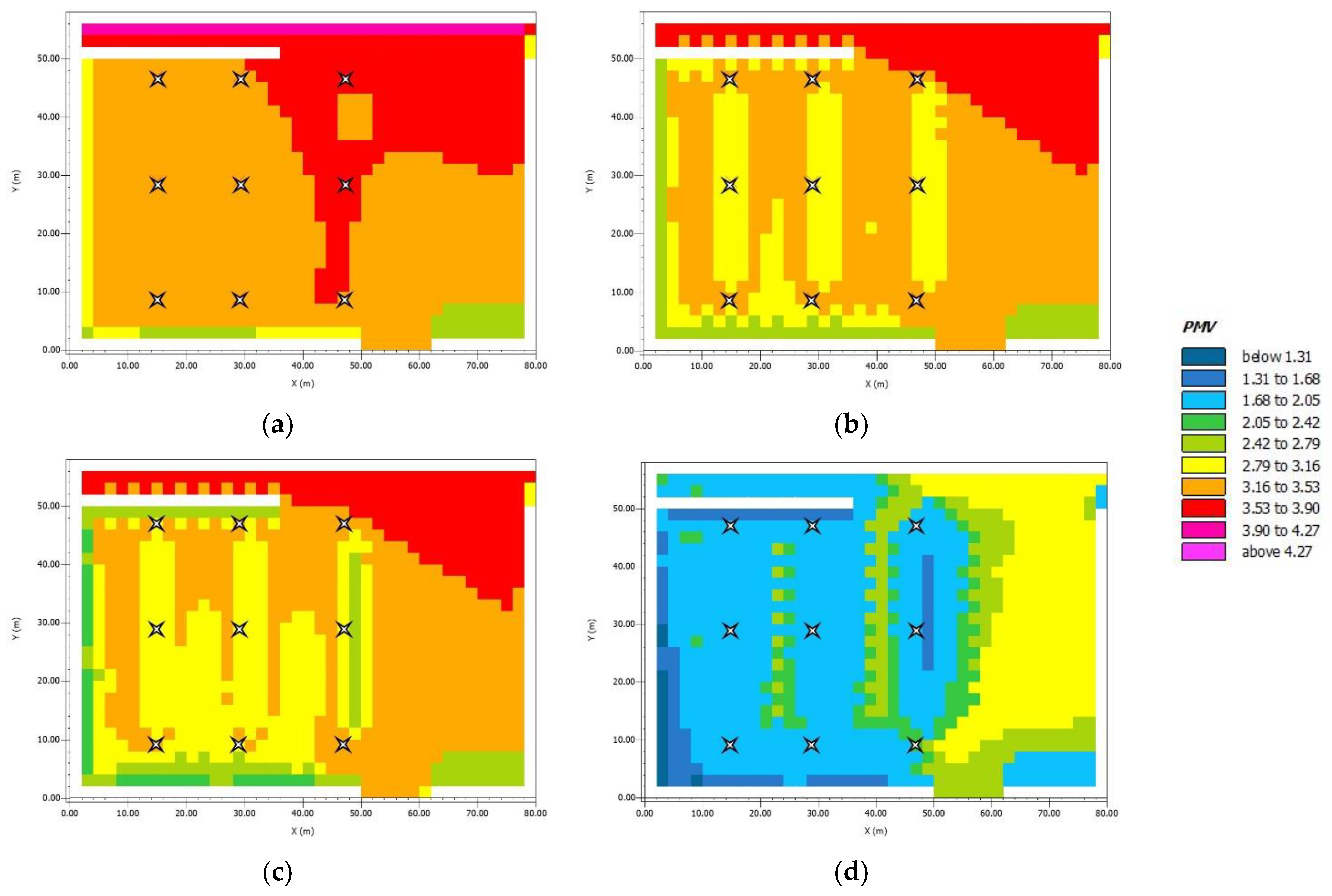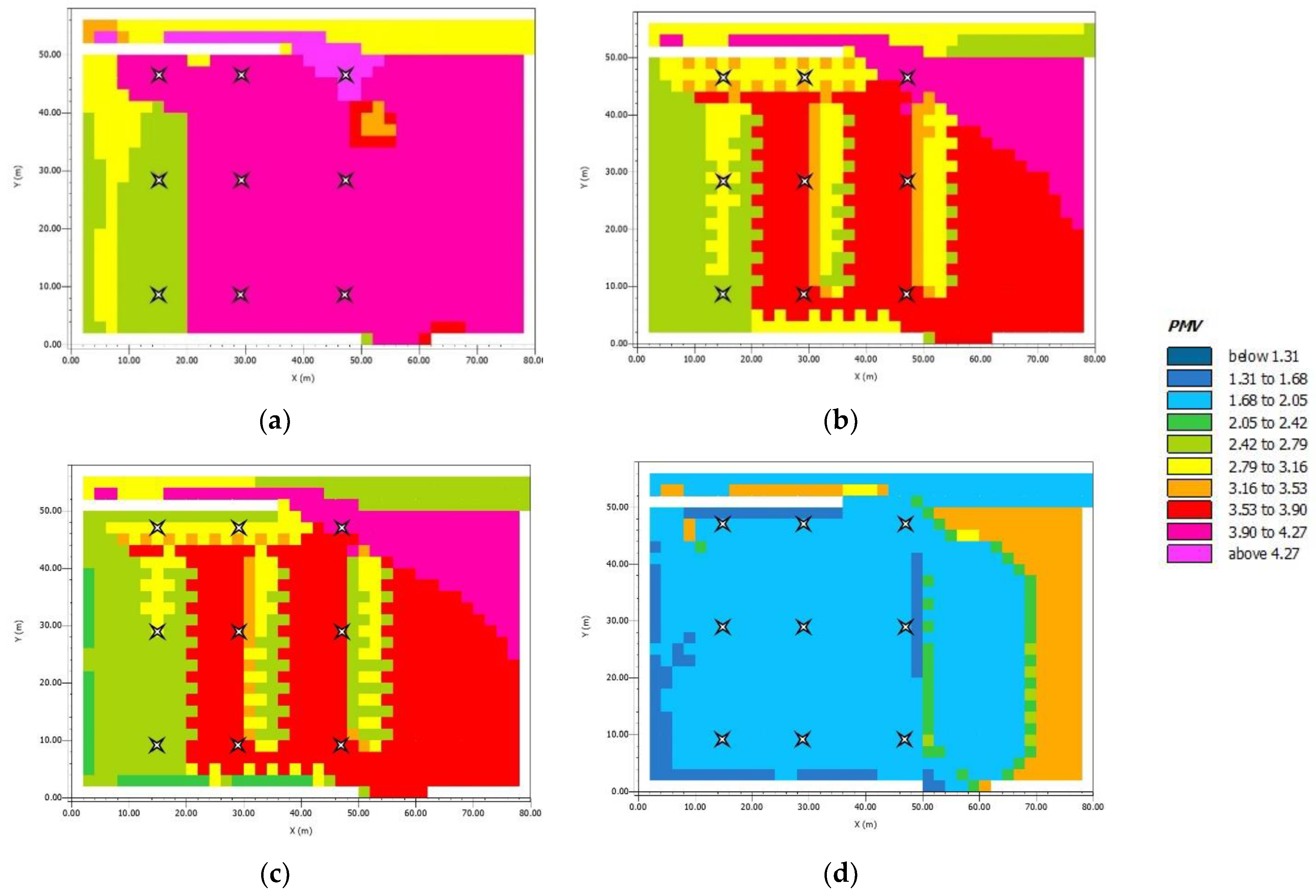1. Introduction
In the past few years, climate change has had several negative effects, such as changing the weather patterns and disrupting the natural balance of Earth’s climate system [
1]. Anthropological analyses of this phenomenon have discovered the dual role of mankind, both responsible for and a victim of global warming [
2,
3]. Humans are responsible for the transformation of rural areas into badly planned and designed urban areas [
4,
5], resulting in a large amount of energy consumption and a consequent increase in pollution [
6,
7]. The frequent use of artificial materials and the increase in anthropogenic heat propagation favor the development of urban heat islands (UHIs) [
8,
9]. They are mainly characterized by urban surfaces (e.g., roads, parking lots, pavements, and roofs) made of waterproof materials [
10] with high thermal capacities. These materials absorb solar radiation throughout the day, store it in the form of thermal energy, and emit it at night [
11,
12,
13]. As a result, air temperatures rise from 1 °C to 10 °C [
8,
14] over 24 h, negatively affecting the psycho-physical comfort of people, who try to counteract high temperatures with higher electricity consumption (i.e., air conditioning), causing further deterioration of the environment and the ecosystem [
15]. In the literature, urban green infrastructures (UGI), building materials (for both road pavements and factories), public transport, water treatment, and urban ventilation are the key factors that affect an urban microclimate [
16,
17,
18,
19]. Therefore, the scientific literature is investigating the best strategies to counteract and mitigate the effects of UHIs [
20,
21,
22]. For example, cool pavements can soften the negative effects of UHIs through different technologies [
23,
24,
25]. Furthermore, permeable pavements guarantee rainwater penetration and evaporation during the hottest hours [
26,
27]. In addition, in parking areas, grass grid pavers combine both technologies for cooling the pavement and air [
28,
29,
30]. Several other studies have demonstrated that the substitution of traditional asphalt pavements with cool ones has beneficial effects in terms of air temperature (AT), mean radiant temperature (MRT), and predicted mean vote (PMV). Specifically, AT reductions of about 5 °C are observed by [
31,
32], while for MRT an absolute decrease of about 15 °C [
33] or a percentage decrease of 10% in summer and 80% in winter can occur [
34]. Moreover, green areas added to cool surfaces can reduce the perceived temperatures and lead to comfortable PMV values [
35,
36].
Due to the recent Italian standard for the promotion of the minimum environmental criteria (CAM) [
37], such measures are mandatory for all public construction works. Therefore, the authors propose a study to identify the best cool pavement to replace existing road asphalt ones. The study area is St. Peter in Chains’ square, in the historic center of Rome. In [
38,
39], the authors carried out microclimatic analyses in the same area and demonstrated the effectiveness of some different cool pavements in terms of PMV and AT values throughout the year. Due to urban planning restrictions and landscaping which constrain the design choices, light concrete slabs or a total grass layer in the parking area gave the best results, suggesting that an even greater UHI mitigation can be obtained by combining these two solutions, and the mechanical good performances of the modular pavements cannot be overlooked [
40,
41]. In this paper, the authors demonstrate how the redesign of the parking area with concrete pavement combined with green furniture and trees can requalify the area. The adopted methodology is useful to achieve the objectives of human well-being and historical heritage protection in a complicated urban context. To this purpose, soft engineering and cool building materials have been merged into just one study through a scientific approach. The software ENVI-Met was used to simulate the climatic trend of the square in July 2021, which is the hottest month of the year. The results in terms of AT, MRT, and PMV allow an objective and quantitative comparison between the microclimatic conditions of the modeled scenarios. Indeed, the current layout is the worst solution, while interesting strategies with cool pavements and green infrastructures can mitigate the negative effects of climate change.
2. Materials and Methods
This article performs a microclimatic analysis in St. Peter in Chains’ square in Rome (lat. 41°53′36.8″–long. 12°29′32.1″).
Figure 1 shows the current layout of the square, where the parking lot has an asphalt wearing course, and the remaining surface is paved with sampietrini.
The thermal properties of pavement materials play a pivotal role in the formation and manifestation of UHIs [
42,
43]. In particular, albedo and emissivity are the two main parameters, as they influence the thermal behavior of the road pavement to solar irradiation [
44,
45]. Albedo is the ability to reflect the incident radiation [
46]. It assumes values between 0 and 1, in which 0 is an ideal black surface that absorbs all incident radiation and 1 corresponds to a white surface that reflects all incident radiation [
47]. Emissivity is the fraction of energy radiated compared to the one radiated by a black body; it ranges between 0 and 1, showing its resemblance to the black body. Emissivity affects surface temperatures, especially during the night, as the heat and the radiation absorbed during the day will be released into the air [
48]. Instead, conductivity and thermal capacity contribute marginally to the cooling of the pavement’s surface temperature. The thermal conductivity speeds up the top–down heat transfer [
49], while the thermal capacity affects both the maximum and the minimum temperatures because it affects the thermal inertia [
50]. According to the UHI mitigation strategies in the literature [
51,
52], this study takes into account the physical characteristics of the existing and the proposed road materials in
Table 1 [
53,
54,
55].
Light concrete pavers substitute the existing asphalt pavement, while green furniture and trees are added to the area. Vegetation consists of a perimeter hedge and rows of trees, placed both on the perimeter and between the parking slots.
Table 2 lists the thermal properties of the green elements and their heights. It also introduces transmittance, which describes the insulating capacity of a body [
56].
This research has been carried out with the ENVI-Met software, which evaluates the urban thermal conditions [
32,
34,
57] through reliable outputs [
58]. The software is structured on four consecutive levels. The definitions of the model and input data are in the first level, the microclimatic simulation is in the second one, and the output files are in the third one. The last level permits us to read and analyze the results using either bidimensional (2D) colored maps (Leonardo tool) [
59,
60] or binary output files in an ASCII format (Xtract tool) [
61]. The implemented model is composed of 40 × 30 × 30 grid cells, with a resolution of 2 m × 2 m × 2 m (x, y, z) (
Figure 2); its domain is bounded by external blue lines (existing buildings and walls) in
Figure 2. It includes the central parking area, an urban road, the surrounding concrete buildings, and an existing tree. The ENVI-Met model consists of a one-dimensional limit (1D), a three-dimensional main model (3D), and a soil model. The validity and reliability of the results depend on the accuracy of the input data (i.e., local meteorological parameters, road surfaces, soil type, existing buildings, and vegetation).
In addition to the current state of the square, three scenarios with a modular light concrete pavement in the parking lot and different green furniture were implemented and simulated.
Figure 3 shows all the analyzed scenarios:
The first scenario (AS) is the current layout, where asphalt and sampietrini compose the pavement of the parking and the carriageway, respectively (
Figure 3a);
The second scenario (LC+G1) has light concrete slabs replacing the asphalt surface in the square and rows of 5 m high trees planted neatly in the parking lot (
Figure 3b);
The third scenario (LC+G2) has light concrete slabs replacing the asphalt surface in the square, rows of 5 m high trees planted neatly in the parking lot, and a 1 m high hedge surrounding the area (
Figure 3c);
The fourth scenario (LC+G3) has light concrete slabs replacing the asphalt surface in the square, rows of 15 m high trees planted neatly in the parking lot, and a 1 m high hedge surrounding the area (
Figure 3d).
To carry out the simulations, the software requires input data, such as the period of analysis and the meteorological data related to the simulation time window. The microclimate analysis was carried out in July 2021, as it is the most severe month according to [
39]. A 72 h analysis was performed, in which the output data were collected in the last 24 h of the simulation. The choice to perform 72 h of analysis was necessary to improve the numerical stability during the model’s spin-up phase.
Figure 4 shows the variation in the air temperature and the relative humidity during the simulated day, extracted from the meteorological input data interface of the ENVI-Met software.
Table 3 summarizes the climatic inputs from the meteorological archives.
Since the existing model and the meteorological input data are the same ones that the authors have implemented in a recent microclimate analysis, the validation procedure [
62] and its results coincide with [
39]. The simulation provides several climatic outputs: in this study, the comparison between the scenarios focuses on AT, MRT, and PMV.
MRT quantifies the effect of environmental radiation on the human body, and it is widely used in external thermal environments and thermal comfort studies [
63,
64,
65]. ENVI-Met performs detailed heat transfer simulations between the surfaces of the model, achieving good results, as reported in the literature [
66,
67,
68]. The software calculates MRT using Equation (1):
where
i is the indicator of the
N surrounding surfaces,
Ti is the temperature of the surrounding surfaces, and
Fp→i are view factors between the person and the whole surrounding environment.
PMV is a human comfort index that allows ex ante and ex post analyses for the evaluation, design, and control of thermal environments according to [
69]. In this study, the reference man is 35-year-old, 1.75 m tall, and weighs 75 kg. According to Equation (2) [
70], PMV summarizes the physical and physiological parameters allowing a correlation between thermal comfort and meteorological parameters:
where
M is the metabolism rate,
W is the external work,
pa is the partial water vapor pressure (Pa),
ta is the air temperature (°C),
fcl is the surface area factor of clothing,
tcl is the surface temperature of clothing (°C),
tr is the mean radiant temperature (°C), and
hc is the convective heat transfer coefficient (W/(m
2 × K)). Three conditions are defined, depending on the PMV values:
Ideal conditions (IC) for a range of values ±1;
Acceptable conditions (AC) for values between (−3, −1) and (1, 3);
Critical conditions (CC) for values over ±3.
Figure 5 shows an extreme daily pattern of PMV because it achieves both hot and cold critical conditions. In this study, the calculation of the different colored areas in the figure identifies the best road pavement to guarantee a good state of thermal comfort. Specifically, the best strategy is the one that presents the smallest CC areas.
4. Discussion
In this article, the authors carried out a microclimatic investigation to assess the current thermal conditions of an Italian square in the historic center of Rome and counteract the negative effects of UHI [
72]. The existing condition has been compared to three scenarios obtained by replacing the road asphalt pavement with light concrete and inserting variable greenery [
73]. The meteorological input data derive from weather archives. However, the constant wind speed and simplified diurnal cycles of temperature and relative humidity (
Table 3) are due to the limitations of data handling by the model. Moreover, the lack of a diurnal cycle in the albedo, as well, as the single value of emissivity (
Table 1), is a limitation in the ENVI-Met model. The current configuration implemented in ENVI-Met has been validated to prove the reliability of the study [
72,
74]. Then the simulated scenarios have been compared in terms of AT, MRT, and PMV in the hottest month of the year.
The results showed that the use of cool pavements and green furniture produces interesting results for all the analyzed variables [
75]:
In terms of AT, the three proposed scenarios have similar and comparable results. They ensure an AT abatement of 2–3 °C compared to the current state of the examined area. In the hottest hour of the day (i.e., 04:00 p.m.), AT decreases from the current value of 32.10 °C to 29.97 °C of LC+G3;
The MRTs show that LC+G3 is the most comfortable solution (from the current 64.53 °C to 32.37 °C) [
76]. LC+G3 shows a 50% reduction in MRT due to the 15 m high trees that shade the area [
77]. Indeed, MRTs of LC+G1 and LC+G2 (65.33 °C and 64.6 °C) differ by few degrees from AS, showing that the shade from the 5 m high trees does not significantly reduce the heat exchange. The results in terms of PMV comply with MRTs. In
Figure 11, the maximum PMV values of AS, LC+G1, and LC+G2 are 4.02, 3.86, and 3.80, respectively. They do not significantly differ in the hottest hour despite the different characteristics of the pavement and the green furniture [
78];
The quantitative analysis over 24 h of PMV disproves what was previously noted at 4 p.m. because LC+G1 and LC+G2 imply a shorter exposure to the worst condition (CC) than AS (
Table 7). LC+G3 is confirmed to be the best solution even in terms of PMV. Its maximum PMV value is 2.22 and it is not exposed to critical conditions during the day [
79].
According to the examined variables, LC+G3 combining cool pavement (i.e., light concrete) and green furniture (i.e., 15 m trees and hedge) is the best scenario. However, it cannot be overlooked that LC+G3 can be achieved only in the long run due to the height of the trees.
The proposed study confirms the data in the literature [
80]: the UHIs depend on different aspects, such as road pavements, the thermal properties of the materials adopted, and the local conditions of the specific site, such as its LAT/LONG location on which the intensity of solar radiation and the buildings surrounding the area examined depend [
81]. Therefore, the meteorological, geographical, and geometrical characteristics of the modeled site and the surrounding buildings affect the results, and their values apply in the case study. However, their trend is scalable to other contexts and cities (geographies).
5. Conclusions
In recent years, global warming has increasingly had serious consequences in terms of climate change. UHIs are caused by anthropization, with strong negative consequences for humans, which encourages people to produce even more pollution to combat them. Several scientific studies have shown how the use of green infrastructure (e.g., green roofs, green walls, green corridors, and green networks) and the replacement of existing road pavements with cool ones (e.g., stone, light concrete, and grass) improve the comfort level of humans. The proposed study performed a three-dimensional microclimatic analysis of Sts Peter in Chains’ square (Rome, Italy) in July 2021 using ENVI-Met.
According to the Italian CAM, the authors propose new layouts for the modeled square by replacing the existing asphalt pavement in the parking lot with light concrete slabs and planting different green furniture and trees. In detail, LC+G1 has trees 5 m high in the parking area, LC+G2 has these as well as a perimeter hedge 1 m high, and LC+G3 has 15 m high trees and a perimeter hedge 1 m high. The comparison between the scenarios confirmed that the current scenario is the worst one, while the proposed strategies involve benefits, especially in terms of AT and PMV. The best scenario is LC+G3 because the higher trees with foliage shade larger areas. Compared to AS, LC+G3 results in a 3 °C AT reduction, a 50% MRT reduction, and comfortable conditions in terms of the maximum PMV value (2.22 compared to 4.02 of AS).
The results showed that great benefits could be obtained from the implementation of the different strategies proposed to counteract and mitigate the effects of UHIs. The use of a cool pavement made of light concrete and a good design of greenery gave the best results. Therefore, in an urban context, the redesign of public space can answer societal needs. For this purpose, further simulations will be carried out according to [
37]. In particular, a grass layer and the light concrete pavement will be joined with photovoltaic surfaces in the parking area to produce renewable energy for the increasing number of powered electric vehicles.
